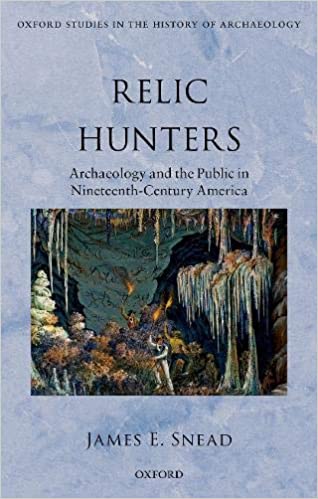The Book
Relic Hunters: Archaeologists and the Public in Nineteenth-Century America. New York: Oxford University Press, 2018
The Author(s)
James E. Snead

Historians writing about early museums and world’s fairs have long considered how audiences may have encountered exhibits at these spaces in the nineteenth century. Unfortunately, even well-documented exhibits are clouded by misleading sources. Blind spots obscure the experiences of visitors to traveling exhibits, dime museums, and the new spaces in the U.S. mimicking older public and private museums in Europe. Little attention is often paid to potential regional differences. Understanding the experiences of early visitors or “publics” encountering these spaces has proven to be challenging as while there exists a bevy of dramatized accounts in sources like newspapers, relatively few other sources exist in archives.
Relic Hunters: Archaeologists and the Public in Nineteenth-Century America (2018) by scholar James Snead represents an in-depth contribution to the literature. The book argues that archaeology was hardly a thing apart as scholars have often written about it, but instead, the emergent science was deeply influenced by a dynamic process of efforts to engage with and educate “the public,” broadly defined, in the United States. Snead notes the ubiquity of the term “relic” in the nineteenth century and its common definition as related to acquiring antiquities or rarified physical traces of past human activity. He argues that a key group of emergent institutions and societies; organizations including the American Antiquarian Society, helped establish a framework for the collecting and study of material traces of past peoples in North America.
The book represents the culmination of an intellectual trajectory Snead has been on since 1984 when an intern at the Smithsonian Institution. Snead is now a Professor of Anthropology at California State University, Northridge. He is also the author of Ruins and Rivals: The Making of Southwest Archaeology (University of Arizona Press, 2004).
Ruins and Rivals emerged as part of an impressive wave of new scholarship on the history of archaeology including Skull Wars by David Hurst Thomas (2000), The Skull Collectors by Ann Fabian (2010), Museums, Monuments, and National Parks by Denise D. Meringolo (2012), and Plundered Skulls and Stolen Spirits
by Chip Colwell (2019). Collectively, these books worked to reconsider the place of archaeology (and human skeletal collecting specifically) in the United States during the late nineteenth and early twentieth centuries. This new work offered by Snead helps to round out our understanding of archaeology during a pivotal time, including in this narrative the dynamic call and response process experienced by archaeologists and audiences thirsty for glimpses into past worlds.
Snead opens his book with the story of the “Kentucky Mummy” a set of mummified Native American remains exhibited on the eastern seaboard in 1816. The book furthers the argument that archaeology in the U.S. was deeply shaped by the mythologized frontier experience, while also reminding the reader that this experience started far earlier than scholars often imagine it. Historians and other writers sometimes equate the emergence of American archaeology with the pillaging of archaeological sites and the growing fear of “pot hunters” seeking antiquities to sell for profit. The widespread worry about these looters resulted in the eventual passage of the American Antiquities Act of 1906, considered a major turning point for both archaeology and preservation.
Turning his view to the early nineteenth century, Snead points to the “profound gulf” between what intellectuals in the United States were coming to see about America’s ancient past and what the public was encountering in many venues large and small. Limiting our view on the history of archaeology to institutions, journals, books, and even the biographies of important early archaeologists hardly paint the full picture. The Smithsonian, to provide one key example, was only just starting to emerge as a force in archaeology in this era.
Snead uses the word “relic” intentionally in his title, pointing to the term’s ubiquity and the fraught ways in which antiquarian object hunting moved between early archeology, “pot hunting,” and looting. Snead further articulates how information about archaeological discoveries became controversial or shrouded in misinformation. The book results from his “desire to explore deep connections between individuals, patrons, and institutions and the need to contextualize their activities in ways that can be generally understood…” (vi)
Drawing from twenty-three different archives the book focuses on the understudied era in U.S. archeology between the 1820s and 1870s. The work features an impressive number of illustrations, including reproductions of numerous historical documents. Using historical newspapers, letters, and published sources the book traces the growth of central institutions in shaping early U.S. ideas about “prehistory” in North America. Snead argues that “In both rural and urban environments public interests in antiquities merged with the equally deep cultural concern for ‘money digging.’” (13)
This book’s greatest contribution is to extend the historian’s gaze further back in time, tracing the origins of archaeology in the U.S. in the early nineteenth century. Much more has been written about the later story, especially the wave of archaeological work that emerged in the late nineteenth and early twentieth centuries. With stories like the so-called Kentucky Mummy that Snead has been tracing for years, we get a unique look at how early U.S. exhibitions were set up and arranged as well as (importantly) some of the popular reaction to these displays.
While this book would make an excellent addition to courses on archaeology, museums, and public history; it is more scholarly than popular in orientation. I would consider the book for upper-division undergraduate or graduate courses on these subjects.
About the Reviewer
Samuel J. Redman is an Associate Professor of History at the University of Massachusetts, Amherst. At UMass Amherst, he teaches courses on public history, oral history, and modern U.S. history. He is the author of Bone Rooms: From Scientific Racism to Human Prehistory in Museums.

0